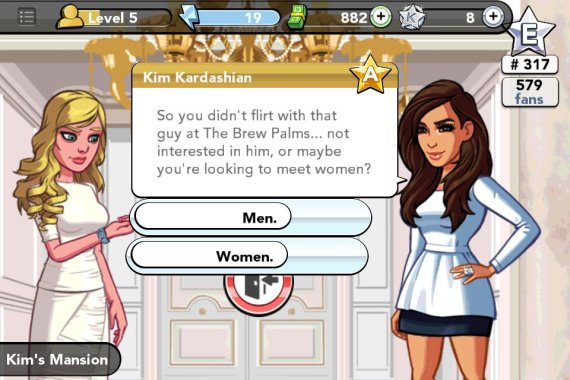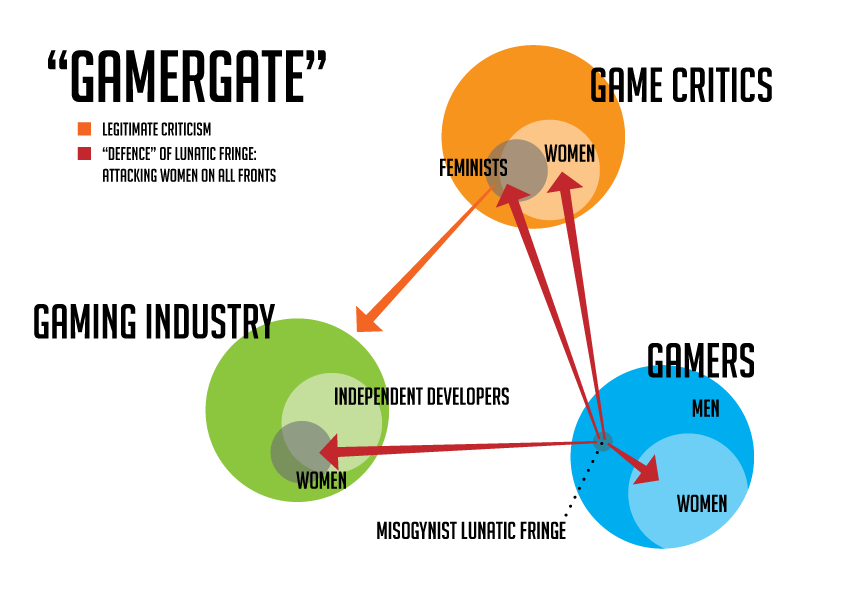Women in Games: An Industry at a Crossroads
 A recent study by ESA (Entertainment Software Association, an industry association that represents the most successful game developer companies) reveals that a whopping 155 million Americans have played video games in 2014, a number higher than expected even by the most hardcore game aficionados. Ours is a golden age of computer and video games, considering such acclaimed and popular titles as Assassin’s Creed, Call of Duty or Grand Theft Auto. But the amount of gamers wasn’t the biggest surprising piece of data in the study. As it turns out, 44 percent of all gamers are… female! Not only that, but 41 percent of game buyers are also women. In addition, women 18 and up represent a much larger group (33 percent) than teenage boys (15 percent), the demographic many still consider the „typical” gamer. Combined with the fact that typical male player is 35 and typical woman player is 43, the data paint a picture wholly different from that we have grown accustomed since the early 1990s. So what’s up with these data? Are there more women than men in the world of games?
A recent study by ESA (Entertainment Software Association, an industry association that represents the most successful game developer companies) reveals that a whopping 155 million Americans have played video games in 2014, a number higher than expected even by the most hardcore game aficionados. Ours is a golden age of computer and video games, considering such acclaimed and popular titles as Assassin’s Creed, Call of Duty or Grand Theft Auto. But the amount of gamers wasn’t the biggest surprising piece of data in the study. As it turns out, 44 percent of all gamers are… female! Not only that, but 41 percent of game buyers are also women. In addition, women 18 and up represent a much larger group (33 percent) than teenage boys (15 percent), the demographic many still consider the „typical” gamer. Combined with the fact that typical male player is 35 and typical woman player is 43, the data paint a picture wholly different from that we have grown accustomed since the early 1990s. So what’s up with these data? Are there more women than men in the world of games?
Women as players
Well, the answer is simple and complex at the same time. In a nutshell, women like games as much (or even more) than men. Just not always the same ones that guys like. And they have secretly (or not so much) loved games for a while now, and were as passionate about their pastime as their male counterparts. The data suggests, however, that it’s a more complex issue than just „not liking” something. But let’s start at the beginning.

Gaming market currently consists of two major industries; one, devoted to large-scale interactive masterpieces that take many hours to finish, played on consoles (video games) or computers (computer games), and the other, devoted to mobile, casual, web-based and trivia/puzzle games the appeal of which supposedly lies in their accessibility and replayability. The latter genre often doesn’t have any plot or protagonist and is simply a virtual, interactive version of the puzzles, board games, trivia games, card games etc. played in real life. For years the first one was thought to be the domain of males, and the other – the preferred hobby among women and kids. These preconceptions, however, are now a thing of the past, as the most recent data suggest.

The ESA study cited above gives 39 percent as the number of the most frequent players that prefer social games (aka the games that „chicks” would play). By platform, the people who play games most often prefer PC (62 percent), home video console (56 percent), smartphone (35 percent) and other mobile devices. By games sold, there’s a difference of preference that plays to each medium’s strength: in video games, the most popular games are shooters (21.7 percent) and action titles (28.2 percent), while computer game lovers prefer strategy games (37.7 percent), role-playing games (20.2 percent) and… casual games (24.8 percent). In an industry where consumers have spent a total of USD 22.4 bln last year alone (of which USD 15 bln was spent on just games), there’s an obvious demand for casual games, which include web-browser simulations, social games, puzzle and trivia games.

Another industry research, conducted on the other side of the pond by the Internet Advertising Bureau paints an eerily similar picture. As much as 52 percent of all gamers here are women, actually overtaking men in terms of having gaming fun. Such casual games as Kim Kardashian: Hollywood are cited as examples of what constitutes a greatly popular casual game, but even among the Brits, female gamers are as diverse a bunch as their male counterparts. The label „casual” now encompasses all trivia, word and puzzle games, and this category is king among all the demographics.

The numbers are showing similar tendencies in the UK as in the US, too: among the 33.5 mln Britons who play games (almost 70 percent of the populace), people 44 and up comprise a larger percentage (27 percent) than teenagers and kids (22 percent). More than half of the older group are female and have played mobile puzzle games, the most popular gaming genre in the UK. Another majority (54 percent) of respondents use their phone to play games, with computers (51 percent) and consoles (45 percent) following suit.

Not surprisingly, the main driving force behind the popularity of the casual game genres are women, but their numbers are so great now that it’s impossible to just label them all „Bejeweled fans” and disregard them as a consumer. Their numbers have grown steadily over the last few years, each year nibbling away at the male-dominated gaming landscape in all the categories.
This year was surprising in that over-50s joined the fray. Between 2012 and 2013 their number skyrocketed by more than 30 percent. Another stereotype-shattering titbit to be gleaned from the research is that the modern woman gamer has played for an average of 13 years. This means that women can’t be lovers of social and casual gaming, as the two types of games have emerged over the last five years. What, then, would have the hardcore game lovers of female persuasion played back then?

The answer is: the same as men, but with titles not being made for them and by them they were probably disillusioned by the industry early on. It’s possible they then quit gaming altogether or switched to casual and social games (like Sims) that catered to their gaming needs best. This is a crucial problem in the industry: there’s a huge demand that is nowadays relegated to the „cheapo” social, mobile and indie games. The biggest video and computer game studios could cash in on that, provided they recognize the demand for what it is, and not just allow the mobile and low-engagement platforms to reap all the benefits via microtransactions or ad revenue. Unfortunately, game creators are almost exclusively males. But just as with female gamers, so too the female game developers face an uphill struggle when it comes to gaming.

Women as game creators
A while back, at the event hosted by Sony there was a noticeable lack of any female presenters, even though, at the time, there were multiple high-level female execs at the company qualified enough to lead the presentation. This was before the full unveiling of Playstation 4, their most recent video game console. The sad reality is, women were and still are underrepresented in the game development industry, not just at the upper echelons of power. Their absence is not as conspicuous, though, and that’s a bigger, more poignant issue. Sony’s example shows that male-centric perspective often goes unnoticed. This may signify a huge blind spot at best, and active discrimination at worst. Either way, it speaks volumes about the culture. But when the accusations begin, people in charge shrug and explain, using the tired old mantra: there simply aren’t enough women in the industry to begin with.

That, however, may no longer be true at all. According to the recent IGDA gaming developer study, 22 percent of all developers are female, up nearly 200 percent since 2009. Their chief complaint at the time of study was not enough time for personal life, with long hours and continuous „crunch” conditions. Most don’t feel that crunch is at all necessary, and very few receive additional compensation for working overtime. Compare that to a different study from 2011, which found only 12 percent of the game-related workforce in the UK were women, while in 2013 only 3 percent of programmers were of the weaker sex.

In any other industry this would already be alarming, but gaming industry is a very peculiar beast; its target is traditionally perceived as male or teenage, and this skews the way games are made and sold, even their protagonists. The study cited above shows that women are, in fact, the driving force of some parts of the industry, and in monetary terms its one of the most profitable areas of mobile, trivia and puzzle games. However, its where the most prestige lies – with computer and video games – where the fairer sex is not just underrepresented, but even actively discriminated against, even sexually. The recent Gamergate scandal shone a bright light onto the industry’s less than salubrious practices of journalism bribery and overt corporate sponsorship. It also revealed a shocking trend wherein female game creators are very often publicly shamed, ridiculed and even threatened with death just because they tend to have a voice in gaming industry or journalism.
The „Gamergate” scandal
Gamergate was a name given to the online conflict that sparked after one Eron Gjoni posted a tell-all post about his ex-lover, Zoe Quinn, who supposedly traded sexual favours to get better scores for her games in the media. Thus began a vehement online battle where female game creators tried to stand their ground, but as always in the Internet, things can never be as simple, and soon many of the female developers started to be ostracized in public for their efforts. More than that, some started to receive threats of violence. This quickly spiralled into an all-out war, in the wake of which many female developers were targeted by multiple communities under the guise of making the industry and media separate. Their supposed goal was to make so that big companies couldn’t use their clout to influence the public opinion. The fallout, however, was far from beneficial to all the parties involved (excluding the vocal anti-feminine communities).

Elizabeth Sampat, a game designer at PopCap (one of the most successful gaming studios globally), says, „I will no longer participate in encouraging young women and girls to become game industry professionals,” adding, „I will continue to fight tooth and nail for every woman who is currently here. But until the industry and gaming culture improves, it’s unethical.” This points to a very bitter conclusion of the Gamergate, underscoring the amount of negativity that boiled just beneath the surface of an otherwise seemingly progressive and open community of gamers. The fact that women in games now would actively root against new women entering the field is tragic, to say the least.

The fact is, after the amount of trolling, sexual harassment, open ridicule and suggestions of sexual bribery for better reviews, women in gaming deserve not to be heard, but to be left in peace to work on games. And although the industry is definitely getting to the point where games SHOULD be made by women and for women (considering how many women play the games), it still lags behind the other corporate and business settings in terms of gender equality and professional advancement. And Gamergate itself has not had any major positive outcomes regarding severing the ties between the media and product creators, the primary reason behind the conflict.

What it did, however, was shine the light on an important part of being an outspoken female game creator. It’s now public knowledge that if you’re a female developer, you should not speak out, lest you draw the ire of the Internet. „Someone just emailed me their fantasy about mutilating my genitals, and murdering me by slicing my body in half. It’s something they clearly spent a lot of time writing,” confesses the developer, Brianna Wu. She had received multiple death threats in the wake of Gamergate and had to move home for fear of her life. However, she also points to the fact that despite all the hatred and negativity, Gamergate publicized the issue, putting it in the spotlight. She goes so far as to say, „I’m one of the best-known women developers in the world today… By attacking me so viciously, they’re helping … to usher in the very game industry they’re terrified about.”
The current hurdles women are facing in the most creative industry of this decade are probably best summarized in a recent documentary entitled „GTFO” (which is a very rude Internet acronym telling people to get out) filmed by Shannon Sun-Hugginson. The film has received a lot of media attention, including the famous comedian, John Oliver. Shannon hopes that „‘GTFO’ can be a 101 intro to women in video games for newcomers to the subject”, and that it would provide „some additional insight and resources to those already involved in that world.” It’s not all negative, which means there’s still hope — and that young girls shouldn’t be discouraged from entering the gaming industry in a creative capacity.
Women as game protagonists
Meanwhile, the industry is making important strides in making female heroines of games more prevalent and less sexualised. Even the recently rebooted Tomb Raider franchise has shied away from the overly tantalizing, big-bosomed image of Lara Croft, replacing her with a stronger, less titillating modern incarnation.

Other upcoming games (like Dishonored 2 or Assassin’s Creed: Syndicate) are similarly including more interesting, multifaceted (not just top-heavy) protagonists, and many games nowadays include a possibility to choose gender for your avatar, tailoring the whole experience to your needs. While it should have been the norm for decades, it’s a great advancement nonetheless.
„We want a variety,” says Kelli Dunlop, a clinical psychologist specializing in the area where psych and tech intersect, on what women want from their game protagonists. She adds, “Sometimes I want to play a damsel. Sometimes I want to play a badass. Sometimes I play a mad scientist. … You need to be able to feel that you can play whatever you want and it is available to you.”

Luckily, we’re getting to the point where female gamers can play games created by them and for them. But will the gaming giants of video and computer games heed the growing trend, or will they be left in the dust by the massively popular casual, mobile, browser and indie games? Time will tell.
VOCABULARY
industry – przemysł, branża
to reveal – ujawniać, pokazywać
whopping – gigantyczny
hardcore – tu: zagorzały, oddany
aficionado – fan, wielbiciel
considering… – zważywszy, że/na…
acclaimed – uznany
creed – kredo
grand theft auto – kradzież auta (nazwa przestępstwa)
data – dane
study – badanie, studium
to turn out – okazać się
in addition – co więcej, ponadto
teenage – nastoletni
demographic – tu: warstwa demograficzna
to consider sb sb – uznawać kogoś za kogoś/jakiegoś
combined with sth – w połączeniu/powiązaniu z czymś
to paint a certain picture – odmalować pewien obraz, ukazać pewną sytuację
wholly – całkiem, zupełnie
to grow accustomed to sth – przyzwyczaić się do czegoś
what’s up with…? – o co chodzi z…? co jest grane z…?
in a nutshell – w dużym skrócie
passionate – żarliwy, oddany
pastime – hobby, coś, co robi się dla rozrywki/przyjemności
counterpart – odpowiednik
to consist of sth – składać się z czegoś
devoted to sth – poświęcony czemuś, oddany
large-scale – (stworzony) na wielką skalę (tylko przed rzeczownikiem)
masterpiece – arcydzieło
casual – przygodny, okazjonalny
trivia – ciekawostki, pytania quizowe
appeal – atrakcyjność, urok
supposedly – rzekomo
accessibility – dostępność
replayability – grywalność (gry)
latter – ten drugi, ostatni z wymienionych
genre – gatunek (np. filmu)
plot – fabuła
protagonist – bohater
board game – gra planszowa
domain – domena (np. czyjaś)
preconception – uprzedzenie, błędne mniemanie
to cite – przytaczać
aka (also known as) – znany również jako
chick – tu: babka, cizia
device – urządzenie
to play to sb’s strength – wykorzystywać czyjeś mocne strony
shooter – strzelanka
demand for sth – popyt na coś
web-browser – w przeglądarce (o grze) (tylko przed rzeczownikiem)
research – badanie, badania
to conduct – przeprowadzić
pond – sadzawka, tu: ocean (Atlantycki) (pot.)
advertising – reklamowanie, reklama
bureau – biuro
eerily – dziwnie, niesamowicie
to overtake sb – wyprzedzić kogoś
to constitute sth – stanowić coś, być czymś
Brit – Brytol (pot.)
diverse – różnorodny, zróżnicowany
bunch – grupa (ludzi)
label – etykietka
to encompass – obejmować
to be king – królować, dominować
populace – populacja
to comprise X – stanowić X, wynosić X
majority – większość
respondent – respondent, ankietowany
to follow suit – podążać za czyimś przykładem, iść w czyjeś ślady
driving force – siła napędowa
to disregard sb – zlekceważyć kogoś
steadily – stale, bez przerwy
to nibble away at sth – powoli coś nadwątlać/nadgryzać
landscape – krajobraz, ogół sytuacji
to join the fray – dołączyć do walki/zawodów
to skyrocket – gwałtownie wzrosnąć, osiągnąć niebotyczną wielkość
to shatter sth – strzaskać coś, rozbić
titbit – ciekawostka
to glean sth from sth – wydobyć coś z czegoś (np. źdźbło prawdy, okruch informacji itp.)
an average of X – przeciętnie X
to emerge – pojawić się, zaistnieć
of female persuasion – płci niewieściej
disillusioned – pozbawiony złudzeń
altogether – całkiem
to switch to sth – przerzucić się na coś
to cater to sth – spełniać coś (czyjeś potrzeby), wypełniać
crucial – kluczowy, decydujący
to relegate sth to sth – zdegradować coś do czegoś, odsunąć coś gdzieś
cheapo – tandetny (pot.)
indie (independent) – gry (filmy, muzyka) tworzone przez niezależnych twórców
to cash in on sth – zbić na czymś majątek
provided… – o ile (nie)…, jeśli…
low-engagement – wymagający niskiego nakładu czasu/sił (tylko przed rzeczownikiem)
to reap the benefits – zebrać korzyści/zyski (z czegoś)
via – za pośrednictwem, przez
microtransactions – mikrotransakcje, małe płatności za przedmioty i usługi wewnątrz aplikacji lub gier
ad revenue – wpływy z reklam
exclusively – wyłącznie
to face sth – stawać w obliczu czegoś
an uphill struggle – ciężka walka, żmudne zadanie
when it comes to sth – jeśli chodzi o coś, gdy mowa o czymś
to host sth – organizować coś
noticeable – zauważalny
high-level – wysokiego szczebla (tylko przed rzeczownikiem)
exec (executive) – członek ścisłego kierownictwa spółki, menadżer wyższego szczebla
qualified – wykwalifikowany
to unveil – odsłonić
underrepresented – niewystarczająco liczny (wśród innej grupy ludzi)
upper echelons of power – wyższe eszelony, wyższe szczeble władzy
conspicuous – rzucający się w oczy
poignant – dotkliwy
male-centric – zorientowany na mężczyzn, skupiony wokół mężczyzn
unnoticed – niedostrzeżony
to signify – sygnalizować, oznaczać
blind spot – ślepy punkt
to speak volumes about sth – wymownie o czymś świadczyć
accusation – oskarżenie
in charge – u steru
to shrug – wzruszać ramionami
tired old X – wyświechtany X (np. o frazesie)
sth is (not) X to begin with – coś (nie) jest X od samego początku
according to – zgodnie z, według
chief – główny
complaint – skarga
crunch – okres wzmożonej aktywności w pracy, w celu wykonania pilnego projektu lub zadania
conditions – warunki
compensation – wynagrodzenie, zapłata
to work overtime – pracować w nadgodzinach
to compare sth to sth – porównać coś do czegoś
workforce – siła robocza, pracownicy
weaker sex – słabsza płeć
peculiar – dziwaczny
to skew – wypaczać
monetary – finansowy
prestige – prestiż, uznanie
fairer sex – płeć piękna
to shine a bright light onto sth – naświetlić coś, uwypuklić (o czymś nielegalnym i tajnym)
salubrious – porządny, zdrowy
bribery – łapówkarstwo
overt – wyraźny, jawny
corporate sponsorship – sponsoring korporacyjny
wherein – w którym, w myśl którego
to shame sb – zawstydzić kogoś
to ridicule sb – wyszydzić kogoś
to threaten (with) death – zagrozić śmiercią
to spark – wybuchnąć (np. o wojnie, konflikcie)
tell-all – demaskatorski
ex-lover – były kochanek/była kochanka
to trade sth to get sth – użyć czegoś by coś dostać
sexual favours – usługi o charakterze seksualnym (UK)
score – wynik, ocena
vehement – zaciekły
to stand one’s ground – dowodzić swojej racji, nie dawać za wygraną
to ostracize – poddawać kogoś ostracyzmowi
violence – przemoc
to spiral – wymknąć się spod kontroli
all-out war – otwarta wojna
in the wake of sth – w wyniku czegoś
community – społeczność
under the guise of sth – pod płaszczykiem/przykrywką czegoś
clout – wpływ, zdolność do wywierania nacisku
to influence sth – wpływać na coś, zmieniać coś
fallout – wynik (czegoś), skutki następcze (czegoś)
beneficial – korzystny
vocal – głośny, głośno wyrażający opinię
to participate in sth – brać w czymś udział
to encourage – zachęcać
to fight tooth and nail – zaciekle walczyć
to improve – poprawić się
bitter – pełen goryczy, gorzki
to underscore sth – podkreślić coś, uwypuklić
to boil – gotować się
surface – powierzchnia
seemingly – pozornie
progressive – postępowy
to root against sth – zabiegać przeciwko czemuś, aktywnie sprzeciwiać się czemuś
sexual harassment – napastowanie seksualnie
to deserve – zasługiwać
to lag behind sth – pozostawać w tyle za czymś
gender equality – równość płci
advancement – tu: kariera, awans
outcome – wynik
regarding – odnośnie, co się tyczy
to sever the ties – zerwać więzy, przeciąć więzy
outspoken – mówiący bez ogródek
lest – gdyż inaczej, żeby nie
to draw sb’s ire – narazić się na czyjś gniew
to mutilate – uszkodzić, okaleczyć
to murder – zamordować
to slice – przeciąć
to confess – przyznawać się
for fear of sth – w obawie o coś
despite – pomimo
hatred – nienawiść
to publicize sth – naświetlić coś, upublicznić
spotlight – światło jupiterów, centrum uwagi
viciously – brutalnie
to usher in sth – wprowadzić coś, pomóc czemuś zaistnieć
terrified – przerażony
hurdle – przeszkoda, problem
to summarize – podsumować
rude – niegrzeczny, wulgarny
intro – wprowadzenie, kurs przygotowawczy
newcomer – nowo przybyły
to provide – zapewnić, dać
insight – wgląd
to discourage – zniechęcić
capacity – tu: rola, stanowisko
to make strides – czynić postępy
heroine – bohaterka
prevalent – powszechny
to reboot – tu: odtworzyć, odrodzić
franchise – marka (filmów, książek, gier itp.)
to shy away from sth – stronić od czegoś
tantalizing – kuszący
big-bosomed – o wielkiej piersi (tylko przed rzeczownikiem)
to replace sb with sb – zastąpić kogoś kimś
titillating – podniecający
upcoming – nadchodzący
dishonored – pohańbiony (US)
multifaceted – wieloaspektowy, wielowymiarowy
top-heavy – piersiasty (pot.)
to tailor sth – dostosować coś
advancement – postęp
nonetheless – mimo wszystko
variety – różnorodność
to intersect – przecinać się, przenikać
damsel – panna, dama (w opałach)
badass – twarda sztuka
mad scientist – szalony naukowiec
to get to the point where… – dojść do momentu, w którym…
to heed sth – zważyć na coś
to leave sb in the dust – zostawić kogoś daleko w tyle (US)
by Prochor Aniszczuk







